ANN's Top 10 (OK, 12) Products/Programs Of 2006
When it comes to the people, planes and products of the aviation
business, ANN firmly believes there is no such thing as an
embarrassment of riches. 2006 saw a spate of new programs and
'gadgets' designed to separate a pilot from his flying dollar...
fortunately, the vast majority of them are quite worthy of
foregoing the occasional $200 hamburger or two.
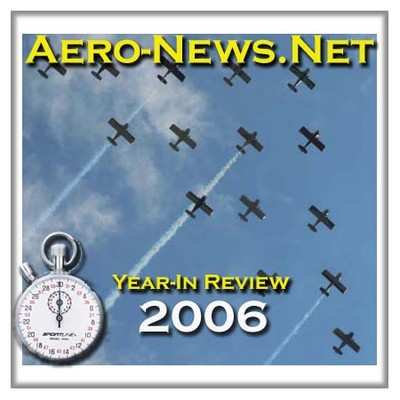
In fact, for 2006 we've had to increase the size of our annual
'Best Of' list to an even dozen to accomodate them all.
From established products that continue to impress, to new and
exciting developments across the range of general aviation... here,
to our eyes, is the second group of three out of our list of the 12
most worthy 'gadgets' and programs of 2006.
Garmin 496 Portable GPS/Moving Map
Just when we thought it couldn't get any better (would YOU want
the daunting responsibility of improving on the highly capable
Garmin 396? Didn't think so...) Garmin unveiled its GPSMAP 496 at Oshkosh.
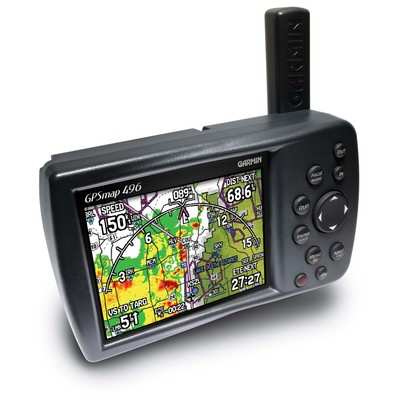
As close to a "must... have... now..." device as you'll
ever see, the GPS496 is a full-color, portable aviation device that
expands on the 396's features by incorporating new SafeTaxi airport
diagrams, as well as Smart Airspace, AOPA's Airport Directory data,
enhanced high-resolution terrain database, aviation database with
private airports and heliports, accelerated GPS update rate, and
pre-loaded automotive maps of North America or Europe.
These features are in addition to the real-time XM WX Satellite
Weather introduced on the 396, that puts weather information where
it's needed most -- in the cockpit, at the pilot's fingertips. Oh,
and it'll play XM satellite radio, to boot.
The Garmin SafeTaxi airport diagrams help pilots navigate
unfamiliar airports with confidence. The GPS496 sports over 650 US
airport diagrams from the factory, along with charts identifying
runways, taxiways, and hangars, as well as the aircraft's exact
location on the field.
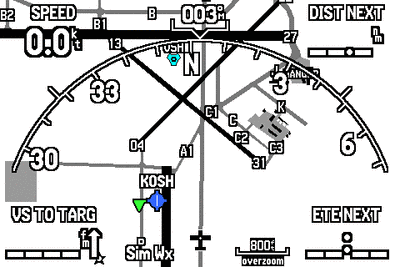
When in the air, the new Smart Airspace feature makes it easier
than ever to identify what airspace lies ahead. Smart Airspace
automatically highlights airspace close to the pilot's current
altitude and de-emphasizes airspace away from the current altitude,
which gives pilots increased situational awareness.
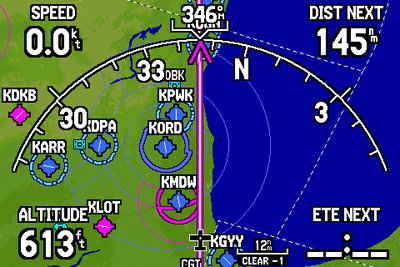
Inclusion of AOPA's Airport Directory data gives the user access
to information for over 5,300 public-use airports and more than
7,000 FBOs. In addition, Garmin's version of the Airport Directory
highlights airports where pilots can save on fuel by using
self-service fueling locations.
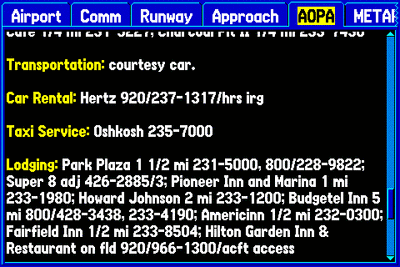
What's more, like other Garmin portable GPS units the pilot can
transfer the 496 to an automobile, as a premium in-car navigation
system with automatic route calculation to any destination and
turn-by-turn voice-prompted directions along the way. And when
traveling by boat, the 496 is compatible with Garmin's new
BlueChart g2 technology -- which turns the unit into a color
chartplotter that displays integrated marine maps with shaded depth
contours, port plans, and other useful items.

With a street price around $2,795 -- all this capability doesn't
come cheap, after all -- the GPS496 comes the closest yet to the
concept of the ubiquitous tricorder from "Star Trek"... all the
info you need, tailored for when you need it, all in a amazingly
compact handheld-or-panel-mounted device.
Hartzell ASC-II Composite Propeller
For all the attention given to flashier developments in general
aviation -- turbocharged engines, ritzy glass panels, and the like
-- it's easy to overlook the importance of one component the
majority of us couldn't fly without... the propeller! (Snooty
turbine owners, move on to the next selection -- grin.) 2006 saw
the evolution of propeller technology, with Hartzell's ASC-II composite
light aircraft propeller.
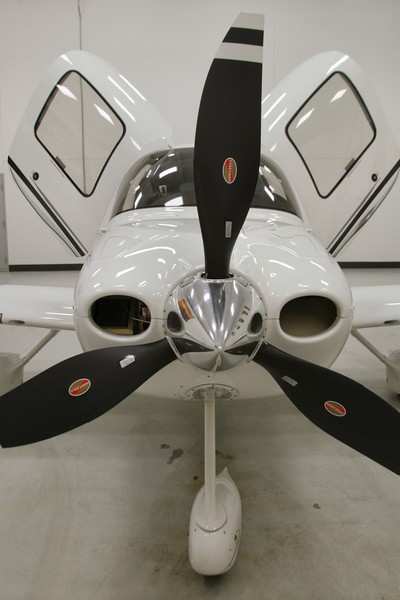
Hartzell's "Second Generation" Advanced Structural Composite
prop is a breathtaking step forward for light aircraft prop design
and engineering. ASC-II sports a composite monocoque structure
composed of carbon/Kevlar laminate, integrated into a co-molded
stainless steel shank. The outboard half of the leading edge is
protected with a co-molded electroformed nickel erosion shield, and
aluminum mesh is embedded into the laminate for lightning
protection.
Hartzell says the new design offers numerous benefits to
aircraft owners, including a 30% weight reduction per blade over
comparable metal blades. Those composite blades also provide
dramatic reductions in inertia, which is VERY important for
aerobatic aircraft to minimize the gyroscopic effects of the
propeller. Often, it also means lower vibration and smoother
operation for GA aircraft.
 The company also states
when it is properly maintained, the Hartzell ASC-II blade will
never require replacement... because, unlike a metal blade, its
surface can be restored.
The company also states
when it is properly maintained, the Hartzell ASC-II blade will
never require replacement... because, unlike a metal blade, its
surface can be restored.
A typical bane of composite propellers is they can't quite match
the performance of metal blades, since metal blades can be produced
with the thin airfoil sections needed for maximum performance.
However, Hartzell says the use of carbon, in combination with
Hartzell's specialized manufacturing process, yields a strong, yet
thin, monocoque structure that permits the use of thinner airfoil
sections at the blade tips and performance comparable to metal.
As further proof of that claim, Hartzell's ASC-II is standard
equipment on the new Cirrus SR22 Turbo.
Max Trescott's G1000 Glass Cockpit Handbook
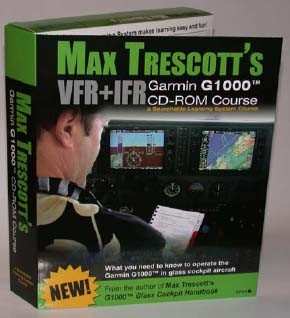 There is a revolution
sweeping through general aviation. Two years ago, few aircraft
shipped with glass cockpits. Now, nearly 100% of all new GA
aircraft ship with glass cockpits, many of them the Garmin G1000.
Whether you’re an owner, potential owner, or renter (more
than 150 locations rent G1000-equipped aircraft), you’ll want
to become expert at flying these exciting new aircraft and benefit
from their enhanced safety.
There is a revolution
sweeping through general aviation. Two years ago, few aircraft
shipped with glass cockpits. Now, nearly 100% of all new GA
aircraft ship with glass cockpits, many of them the Garmin G1000.
Whether you’re an owner, potential owner, or renter (more
than 150 locations rent G1000-equipped aircraft), you’ll want
to become expert at flying these exciting new aircraft and benefit
from their enhanced safety.
Until now, there’s been no single source of information
that educates pilots about all of the features and benefits of
flying the G1000, and how features vary between aircraft
manufacturers. Whether you fly Beechcraft, Cessna, Columbia,
Diamond, Mooney or Tiger aircraft, you’ll learn which G1000
features apply to your particular aircraft.
Max Trescott, a Master CFI who’s trained and taught
extensively in glass cockpit aircraft, takes a narrative approach
to explaining the G1000 in ways that both beginners and experts can
understand. In "Max Trescott's G1000 Glass Cockpit
Handbook," the author not only explains every system
feature, but also provides information on when and why you’d
use a particular function are also included. The book is loaded
with illustrations and “tips” gleaned from leading
glass cockpit instructors around the country.
Instrument pilots will find the book valuable, since it explains
how to fly instrument approaches with the G1000, and integrates the
proper use of an autopilot throughout the approach. Data link
weather and Stormscopes® are popular G1000 option, and the book
details how the weather data is gathered and delivered to the
plane, so that you’ll understand the limitations and proper
use of the information.
The book is $34.95, soft cover, 244 pages, 40 in color, and
illustrated with more than 275 computer screen shots and
photographs, glossary and index. If you prefer your information in
the digital format, Trescott also offers a two-disc CD-ROM for
$99.95. Either way... this should be required reading for all
G1000-jockeys out there.
Coming Wednesday... The Next Three Selections For
ANN's Best Programs And Gadgets Of 2006
 ANN's Daily Aero-Linx (05.06.25)
ANN's Daily Aero-Linx (05.06.25) ANN's Daily Aero-Term (05.06.25): Ultrahigh Frequency (UHF)
ANN's Daily Aero-Term (05.06.25): Ultrahigh Frequency (UHF) ANN FAQ: Q&A 101
ANN FAQ: Q&A 101 Classic Aero-TV: Virtual Reality Painting--PPG Leverages Technology for Training
Classic Aero-TV: Virtual Reality Painting--PPG Leverages Technology for Training Airborne 05.02.25: Joby Crewed Milestone, Diamond Club, Canadian Pilot Insurance
Airborne 05.02.25: Joby Crewed Milestone, Diamond Club, Canadian Pilot Insurance











